After a big book launch, sales fall off a cliff and are hard to regain. If you are lucky, your monthly sales will level off at something that is still meaningful to you (maybe $1,000-$3,000 per month), but certainly not enough to make a living. Once you learn this – as I did – you’ll quickly want to add another product so that the two combined can support you once the launch revenue has dried up.
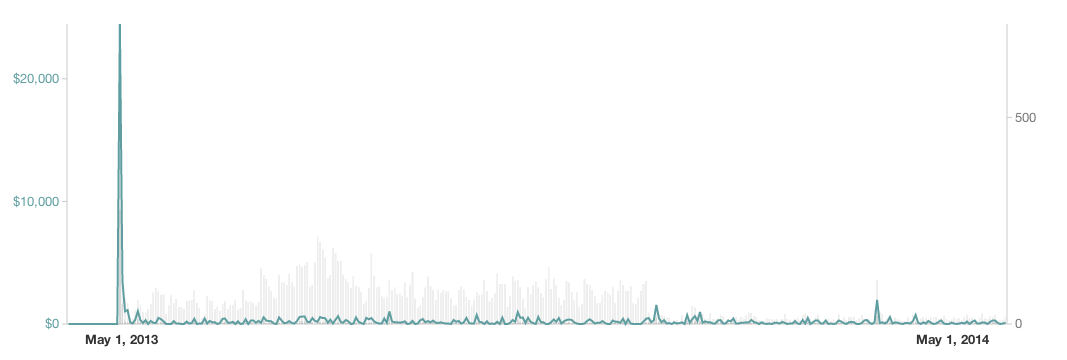
Changing my thinking
That’s how I used to think. Now, I’ve seen that it doesn’t have to be true.
Let’s paint a different picture. Let’s say that you build a list and do a big product launch – as you should. Then afterwards, since it was so much work, you take a couple weeks off to recuperate. You’ve made enough money for the month so you’re set for a little while.
But let’s say instead of moving on to the next project (which is what I did), you got back to work improving and promoting the book. No matter how big of a launch you did the first time, I guarantee you didn’t reach the full potential of your market. I bet you didn’t even reach 1% of what you could have done.
Saturating your market
Last spring I was in Oslo, Norway for Chris Guillebeau’s visit to his very last country. One night at dinner with a small group of bloggers, the discussion turned to product launches. Specifically the recent launch of B-School and how, because of affiliates promoting the launch, it had been everywhere. So much that it was starting to annoy readers of several of these blogs (since there was an audience overlap). One person said “Yeah, Marie Forleo’s content is everywhere. It’s getting annoying to have her on every blog I read!”
My response was, “Who’s Marie Forleo?”
I’d never heard of her. The person that everyone else at the table thought had completely saturated her market, I had never heard of.
You probably feel like you are well read and spend (probably too much) time reading other blogs. But really you read everything in one tiny little section of the internet. Someone who is completely ubiquitous to you is non-existent to someone else who reads every single blog in a circle half a step outside of yours.
Who is Pat Flynn?
Within 5 minutes of picking up my swag at my first World Domination Summit, I met Caleb Wojcik (who has since become one of my really good friends). During that first conversation he mentioned Pat Flynn and his site SmartPassiveIncome.com.
Just like with Marie, I responded, “Who’s Pat Flynn?”
I’d never heard of him. Caleb seemed really surprised. Pat was ubiquitous in the blogging circles that Caleb ran in. But I’d never even seen his blog.
Marie Forleo mainly writes to female business owners, so I’m not exactly in her market. But I am definitely in Pat’s market. In the 2 years since then I’ve listened to most episodes of Pat’s podcast (which is excellent) and he’s become a good friend.
Even the people who you think have saturated their market haven’t even come close. The internet is huge. After one product launch I bet 99% of the target market for your book doesn’t even know you exist.
4 ways to continue promoting your book
Now that we know your market isn’t saturated, it’s time to figure out what to do for promotion. It’s actually quite simple: exactly what you did before the book launched.
1. Epic blog posts
Writing really good blog posts that link back to your book is a great way to drive traffic. Now you just need to balance linking directly to your sales page versus trying to email addresses and pitch them later.
About 6 months after my first design book launched I noticed a huge drop in sales. I barely made $200 in one week from two books combined! When I asked a few friends about it, they said, “when was the last time you wrote about design?” Good question. I’d moved on to blogging more about marketing topics since I had just launched ConvertKit and was gearing up for the launch of Authority.
Taking their advice, I wrote a detailed design post that linked to Designing Web Applications and sales immediately jumped up.
The most obvious way to continue promoting your book is to continue teaching great quality content for free on your blog and on other sites through republishing and guest posts. Then don’t be afraid to link back to your book.
2. Sample chapters
When you give out sample chapters, you should be capturing email addresses. Ask for an email address so that you can send the sample chapter straight to their inbox. If you phrase it correctly it will feel like a feature (easier to read on you phone or tablet) rather than a gate between them and the free content.
Here’s how I do it for Authority.
Note that I am also offering a free 30 day course on profiting from self-publishing. You can opt out and just get the chapter, but 95% of people who fill out this form leave it checked. This becomes important in our next promotion method. I should note that about 5% of people visiting the sales page enter their email address for a sample chapter.
Once you have these email addresses, you can market to them and do small launches to them throughout the year. We’ll cover that soon.
3. Email courses
Even people who are interested in buying the book won’t necessarily purchase the first time they visit the sales page. Many won’t remember to come back. Email courses are a fantastic way to remind people about the product and continue to convince them that it is a good fit for them. That’s where the sample chapter email list comes in.
When you leave that checkbox checked, you get a series of emails teaching about self-publishing. It’s all sections taken directly from Authority or the posts promoting it. In other words, I’m reusing content in order to promote the book. This email sequence gradually builds up trust and provides a sales pitch timed exactly for them. So you can make sure they get the right emails at the right time!
The emails at the beginning of the sequence build trust and teach about the product, then further on in the sequence there is more of a sales pitch. I alternate between educational content and hard / soft sells. I haven’t changed this sequence in over a year and it still continues to sell books each week. That’s the power of email courses!
4. Affiliate deals
It’s hard work to go find new members of your audience one by one or even a couple hundred at a time with a well-targeted guest post. Instead, what if you could add hundreds of email subscribers and dozens of buyers in one go?
My friend Brennan did this recently with his book Double Your Freelancing Rate. After a successful launch to his own audience, he went on a tour of related audiences. In each case he found an audience of freelancers and asked the host if he could teach their audience how to raise their rates. All freelancers want to know how to charge more, so it was an easy pitch.
They host a joint webinar, teach about raising rates in the webinar, and then end it with a solid pitch for the book. Profits are split 50/50 between Brennan and the audience owner. More book sales, and Brennan is able to grow his email list even faster.
New content and small launches
A typical book pre-launch list will convert at about 10%. That means for every ten people subscribed to your email pre-launch list, only one will buy at launch. What happened to those other nine people?
Too often we assume that since someone didn’t buy during the launch, they don’t want to buy at all. But really it comes down to three reasons:
- either they weren’t convinced of the value,
- it is no longer relevant to them,
- or the timing wasn’t right (money or time may be too tight right now).
Most of those objections can be overcome with time. Meaning you should continue to market to the other 90% of your pre-launch list well after the launch.
Regular updates and promotion
For some reason, I find it difficult to talk about a book (other than casual mentions) after the launch. The urgency is gone (usually from a discount) and there isn’t anything new about the book. So there is nothing to talk about.
Unless you add to and update the book.
That’s exactly what Sacha Greif and Tom Coleman did with their book, Discover Meteor. The book did well when it launched, but they didn’t stop there. They immediately started adding to and updating the book. That’s the wonder of digital books: constant changes don’t require releasing a new version.
Each time they made an update, changed a chapter, or added new content, they wrote about it on their blog and told their email list. The book got better and they drove more sales. The Meteor development language the book is about is constantly updating and changing (it hasn’t even hit version 1.0 yet), so they always have more to write about.
They could have immediately moved on to another product, but instead they focused on one core product and kept making it better.
Two full-time salaries
Discover Meteor has made over $250,000 in the last year. It was a crazy amount of work at first, but now Sacha and Tom each work on it about 5-10 hours per week. Driving more sales, hosting events, and spreading the gospel of Meteor. Splitting that money 50/50, they are now making about $125,000 per year off of part time work. Not bad!

None of this would have happened if they launched the book, made what they could, and then sat back and complained that book sales drop off after launch.
New editions and big launches
One tactic that Sacha and Tom haven’t done yet is do a big launch for an entirely new edition. I’ve done this with two books, The App Design Handbook and Authority, with huge success. I add more content and update the book, build up to it with a solid launch sequence, offer a discount during the 24-hour launch period, and watch the sales flow in!
For whatever reason, there are plenty of people on your list who only buy during a launch. So the solution is to launch more than once.
I plan to launch each product at least once per year. That means content stays fresh, sales continue to roll in, and the products don’t get neglected. One big launch per year is the minimum of what you should do.
Back to the numbers
Let’s jump back to the numbers of making a full-time salary from one book. We started off with the sales numbers for the first year of Authority. But I cropped the chart so it didn’t show the total: $93,890. From one book.
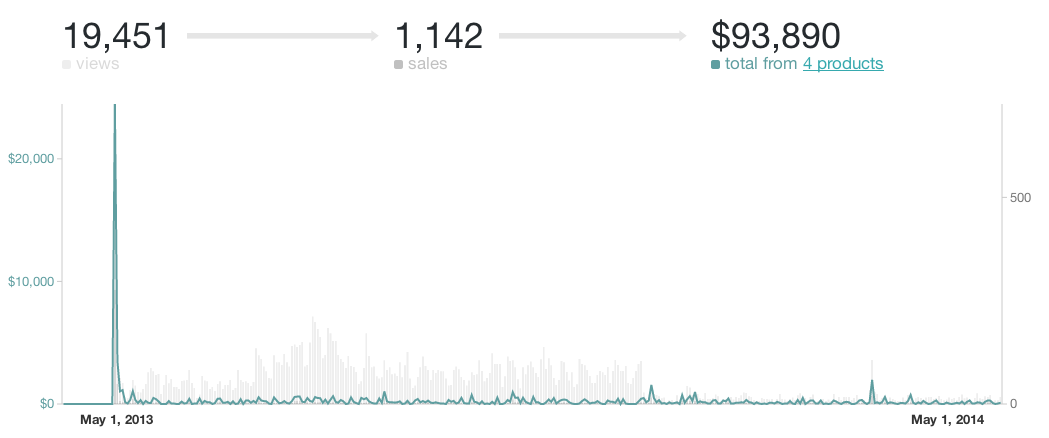
In my last salaried position I made $63,000 per year. Sales from one book are far higher than that! Also that’s with two other books and two courses that I was working on at the time. What could Authority have done if I’d focused on it full-time?
My other books
The App Design Handbook made $59,042 in it’s first year. I launched it before Gumroad had pretty graphs, so I can’t show you one, but that’s still almost a full-time salary.
Designing Web Applications made $123,157 it’s first year. Where I live that’s a wonderful full-time salary! All from one book. And without ongoing promotion as described above.
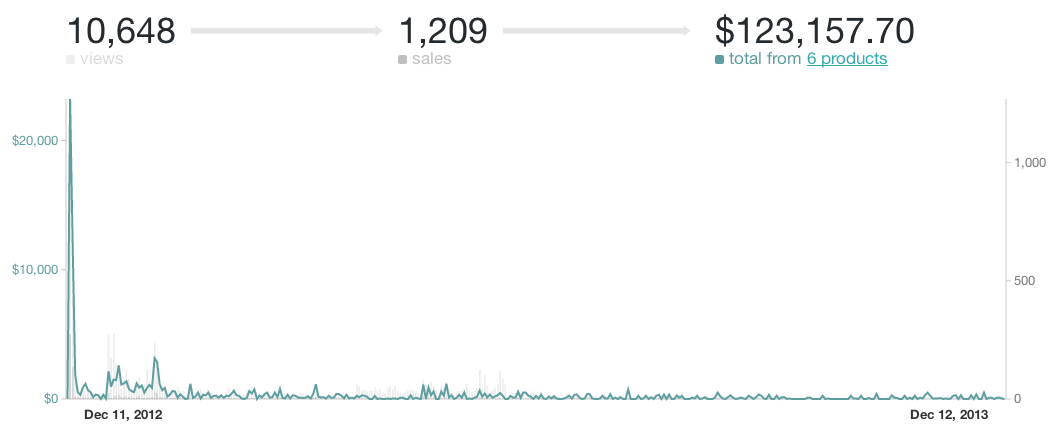
Now you may be looking at this and thinking “Yeah, but most of that is from one big launch. What do you do for money the rest of the year?” And you’re right. But I cut each of these graphs off before showing the next launch.
One friend has a massively successful business that does most of its revenue in a couple weeks each year. When I mentioned that must be really annoying to not make consistent income, she just said “grow up and learn to fucking budget.”
Point taken. Just because you make a huge amount of money one month and very little the next few months doesn’t mean you need to spend everything and go broke. Understand that product launches result in cyclical revenue. Plan for it and it is actually far better to get $120,000 up front in one chunk than it is to get $10,000 per month.
Thanking a few people
I’ve found that it takes time to learn these lessons. I’d always (wrongly) assumed that once a product launch was over, it was time to automate the sales and move on to the next product. I’d like to thank Ryan Delk and Sacha Greif for showing me that it doesn’t have to be that way. And really for helping me see another story in my own sales numbers.
Now go write!
If you’ve been on the fence about writing a book, just start. Authority gives you the blueprint. For the rest of you who already have a book released, focus on it more. Don’t be in such a hurry to move on to the next thing. You haven’t saturated your market. Keep making the product better and getting it in front of new people.
You can make a full-time income from one book.
Taking your book to the next level.
If you’ve already published that book and started growing your audience-based business, then I’ve got a lot more training for you. There is an entire group of people who say, “I wrote my book, now what?”
Well, that’s just the beginning. I’d like to teach you how to:
- double your revenue with workshops,
- launch the next edition of your book,
- drive ongoing sales,
- cross-sell other products to the same audience,
- and build a sustainable business.
That’s what my new course, Building Profitable Audiences, is all about. The next step to grow your audience and get over 6 figures per year.
The course launches next Wednesday (August 13th, 2014) at 11:00 AM Eastern. Sign up here for the waiting list.

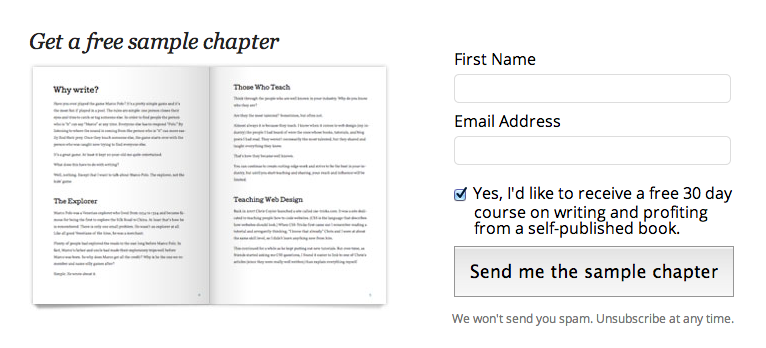
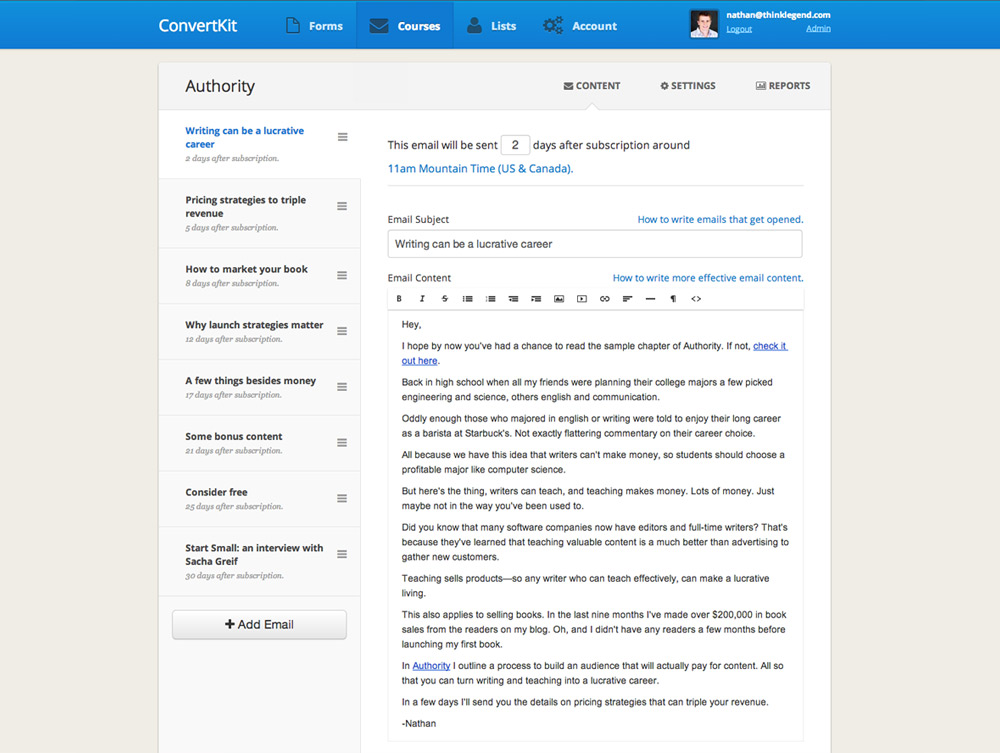
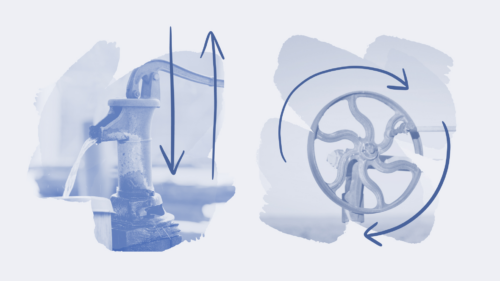
My wife and I launched our first product after reading your Authority ebook. We used a PWYW pricing model with Gumroad when we launched June 10th. I’m looking at Gumroad right now and I see we’ve had 632 sales for $6,368. Thank you for showing us that this can be done!
I’m passing this article on to my wife as we figure out how to keep sales going for her eBook.
Thanks again Nathan!
I love this Donnie. Love that you’ve been inspired by Nathan also. And so glad to see PWYW worked so well. Would love to interview you about it!
Wonderful article Nathan!
I am in the process of writing my first how-to book right now and always find your content so incredibly helpful and inspiring.
Thank you so much for sharing!
Nathan, the question I’m still left with after reading Authority (which was very good) was how you actually get people to see those epic blog posts you mentioned in the book and this article. My blog gets very little traffic and it’s incredibly difficult to sell something based on that traffic.
Thanks,
Justin
I’m still in the early stages too, but here are the ways I plan to get the epic posts in front of people who could be interested.
Write the content for other sites which already have people in my target audience. (Guest Blogging) I plan on putting most of the best stuff out like this. Then in the bio and by-line offer a email mini-course they can opt in to by clicking a link to my site.
Then, for the 1 or 2 epic posts I’ll have on my own blog I plan to try to promote them through big forums and aggregation sites (reddit, etc).
Hi Nathan,
great content as always. I’m half-way through writing my first ebook and I really can relate to the things outlined in this article.
Since I basically started from scratch a few weeks ago I’m struggling more with how to get people to sign up to my mailing list in the first place (currently working on a free incentive for subscribers) but reading such inspiring posts keeps me quite optimistic that it will work out.
Thank you for that.
You’re certainly someone to watch and listen to for how to sell a book. Only it’s not just a book. You teach that it should always be seen as a product.
One of the great lessons you’ve taught me is to think of my product in terms of its value to different sets of people. The different price ranges being one.
Now all I have to do is to think of a topic for my product.
Thanks so much Nathan,
I am going to refocus my efforts on my book. I launched it earlier this year with Gumroad, thanks to you. Thanks for the constant encouragement. Continued success to you and your family!
Thanks for this post, Nathan.
After following you and Ramit Sethi for some time, I decided to stop procrastinating and finally create my first product (video course). Only thing left to decide is whether to go with PWYW or fixed price.
Here, you mentioned affiliates as a part of a strategy. My idea was to reach out to bloggers who have similar audience and offer 90% discount to their audiences.
I’m interested in your opinion here: affiliate deal or huge discount for audience?
Great article, and thanks for the mention!
I’m glad you changed your mind about this. I always wondered if the “one big launch wonder” kind of marketing was just for the “IMM gurus” out to make a quick buck. Meanwhile, the couple of marketing experts I follow (who have a small but loyal following) have been selling the same core book in their businesses for several years, updating the editions with improvements.
Hold on, I’m not saying I changed my mind about big launches. That is definitely still the way to go. Anyone who soft-launches a book or otherwise just “puts it out there” instead of doing a big launch is missing out on a ton of sales and making a huge mistake.
I just now think you should continue focusing on the product after that big launch. Since you can clearly keep driving sales.
I understand. I was referring to the types of big launches where the ‘guru’ offers a book, app or plugin for a fast buck and never updates it again.
Thanks for another great article packed with useful information and lots of inspiration.
Organic growth appears to be the way to push sales because it builds interest and keeps your publication on people’s minds. It allows you to open new niche areas as well, maybe ones that you haven’t seen as being important to your particular ideas.
The ‘big launch only’ is ok if you have an extended group of fans/links into podcasts and blogs that allow you to gain a larger audience fast. But if you are starting out it is hard to capture that interest/trust of ‘sideline’ viewers – so having the product have a longer life-cycle is preferable.
Showing you are committed to that audience is an important fact that will sway the sidelines.
It seems like a ‘natural’ to survey your audience after the first edition of your book and then include other information – either as blog posts, mini-reports in a subscriber group, podcasts, interviews or other ‘added value’ that can be built into second and third iterations of the same book…the idea of a trilogy or series of books.
As you have done in this article – mentioning the ‘foundation product’ regularly will keep it fresh and up-to-date with readers whereas moving too quickly onto another product (in a different genre/niche). I think it is a good tactic to rewrite and add value to your initial source of inspiration
Fascinating insights – thanks for being so transparent about your process!
Love the playful style illustration at the top as well. Did you make it yourself?
No, it’s stock.
Nathan,
I’ve had a chance to listen to your podcast with Pat Flynn and Chris Ducker and both were highly motivating.
As a recently married 24 year old, in a fairly similar situation to your own, it’s awesome to hear about the success you’ve generated for yourself and the possibilities available if you put in the work.
Thanks for the motivation, looking forward to watching your future success and personally working towards matching what you’ve been able to do in my own niche!
Thanks man,
Rob
Nathan, you make an excellent point about launching new editions of digital books. In a way, this is a digital application of a practice common in print publishing: launch with a hardcover and then offer a trade paper edition later on.
The headline on this post has the potential to be full of hype. You delivered the goods on the headline and went far beyond.